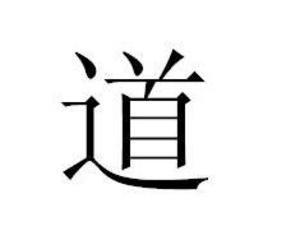“DAO”AND DAOISM (TAOISM) IN 1970’S AMERICAN POP CULTURE
How many people out there grew up watching David Carradine as Kwai-Chang Caine in the TV series Kung Fu? Remember how cool he looked doing all those quick moves? The rest of the time he would walk around contemplating his next move with those flowing robes in that big temple. Little did we know he would end up as a sword-chopping gangster in Kill Bill. Anyway…
NOT ONLY BUDDHISM – BUT DAOISM TOO…
Well, you may also remember Kwai-Chang was a monk from a shaolin temple in northern China. Buddhism was the big religion of that day, but Daoism (also spelled as Taoism) figured in as a major religion as well.
THE MEANING OF A SINGLE WORD: “DAO” or “THE PATH”
Among Daoism’s tenets is the central concept of “dao” – literally “the path” – which is depicted in the Chinese language as “dao” (see IMAGE 1). Dao” (also “tao”) refers to the singular path a person may walk – if walked correctly – to achieve fulfillment, enlightenment, or atonement (at-one-ment) with God. While “The Path” of one’s life may be looked upon as a singular movement filled with many teachings, “dao” is a singular word likewise comprised of many components – all of which are filled with meaning.
DAO
The written word “dao” may be interpreted as having two distinctive parts: the “face” portion on the top, with a body component on the bottom. Together they depict a “wanderer” and all the possessions he/she carries. The actions of the life-traveler or wanderer are implied with in the features of the word as we shall see below.
HAIR ON THE HEAD
The bottom and side portion of this word depicts the body of the life-traveler (a “walker”, so to speak) facing leftward with a head on top, an arm boldly swinging forward to the left (see IMAGE 2), and a left foot making a cautious “tiny step” into an always-precarious future. The long right leg swings boldly underneath to the right, behind the walker, providing a strong physical foundation for the “head” (see IMAGE 4) resting on top. The head is depicted as “hair” on top of a “face” (see IMAGE 5) written as a kind of an upended rectangle with several horizontal lines representing the furrows on the forehead as the distinctive features of the walker’s face.
For more information on the “face” concept click here.
VALUE and “FACE VALUE”
Interestingly enough the “face” (see IMAGE 3) portion of this word also bears the meaning of a related but entirely different word in Chinese language – the “cowry shell” . Although “cowry shell” is written exactly the same way as “face” , the “cowry shell” is a pictogram representing the small oblong cowry snail shell (also “cockle shell”) which can be found on the seashores up and down the coasts of Asia. Cowry shells were small and sometimes very colorful. Ancient Asian people valued extremely colorful cowry shells highly and treasured them as prized possessions. Over time, cowry shells became the first form of money currency in early Asian cultures. They were beautiful to behold, yet small enough to carry in a pocket or a pouch – a feature which helped facilitate early forms of commerce. Cowry shells were eventually carried anywhere as an easy form of cash.
Because cowry as a word represents “money”, it can also be equated with the concept of “value”. By extension, the same word depicting the “face” can thus be equated to “value” also.
In today’s modern English language we have the perfect expression which fuses these two concepts perfectly: “face value.
FACE
Among people, “face value” is the value we assign to the person behind the face. When walking down a street, people will simultaneously see the person as an individual, and the value they represent.
For more information on the “face” concept click here.
Collectively, this one word “dao” encompasses all of the concepts I have discussed above, and they are all wrapped up together by a single story arising in ancient history. Amazing…
Have fun!
– John
To subscribe to these articles, email me by clicking here
To read other cool articles:click here
For RSS feed:http://www.associatedcontent.com/rss/user_76423.xml
Legal stuff: Disclaimer & Safety Notice: Author does not warrant or assume any legal liability or responsibility for the accuracy, safety, completeness, or usefulness of any information, apparatus, product, or process disclosed or referred to. Information is provided for informational purposes only. Any actions or assumptions taken on the reader’s part as a result of any information disclosed by Author are taken entirely at the reader’s own risk. Author shall not be liable for any errors in the content, nor for any actions taken in reliance thereon. Furthermore, Author shall not be liable for any loss of profits, contracts, opportunities or any direct, indirect, consequential loss of any kind (including death and/or injury), business interruption or loss of property arising out of or in connection with the use of the information herein. News items, opinions, and/or statements posed by author may be unsubstantiated and should be considered also as such. Unless where expressly stated, Author claims no express or understood association with any person, entity, or third party mentioned. “Cibola International” is a service mark (SM) and trade mark (™ ®) belonging expressly to John Melendez with all rights reserved worldwide.
© 2008 John Melendez – All rights reserved worldwide. Duplication in part or in full is prohibited. Violators will be prosecuted.
Reference:
- Don Voss – shaman
